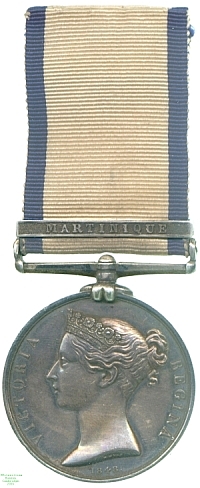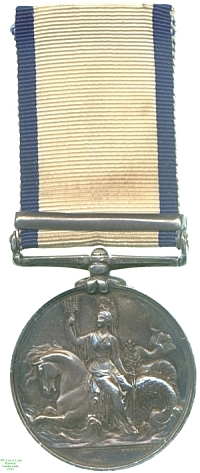
Obverse, a bust of Queen Victoria

Reverse, Britannia with a trident seated sideways on a seahorse

Obverse, a bust of Queen Victoria |

Reverse, Britannia with a trident seated sideways on a seahorse |
Just as in 1848 the extensive land campaigns of the Napoleonic Wars and the other conflicts of the pre-Victorian era were recognised by the issue of the Military General Service Medal, those serving in the Navy at the time were recognised with the Naval General Service Medal. As with the Army equivalent and the East India Company's related award, many of the battles for which the medal was awarded had been fought so long ago that few if any claimants survived.
In addition, bars were awarded for many actions whose significance and size were, despite the heroism displayed by those involved, relatively minor. The result was that many of the bars were issued in tiny numbers, with some combinations all but unique, and the medals command a very high price among collectors because of this rarity and individuality. This in turn, along with the manufacture in most cases of more bars than were eventually issued, has led to the `improvement' of many common awards where recipients' names are shared with those present at `rarer' battles. The medal also shares with the Military General Service and Army of India Medals the oddity that Queen Victoria, whose portrait they bear, was not the ruler under whom the battles for which it was awarded were fought.
The island of Martinique, home of Emperor Napoleon I's wife the empress Josephine, was colonised by the French in 1660, and by the 1790s was infamous in Britain not just as a rich colony, but also as a remaining home of slavery. Britain took the island in 1794, ending slavery, but it was reinstated on the return of the island to France by a treaty of 1802. In 1809 the British invaded again, and held the island until the definitive return to France in 1815. Bars were awarded to both the NGSM and the Military General Service Medal for participation in the invasion.
This example was awarded to Orderly William Frost, who served aboard the 74-gun 3rd-rate battleship HMS York. His presence on the ship at this time has been verified, and the General Honours Roll confirms the award of the medal to him. Lester Watson purchased this medal at some point before 1928.